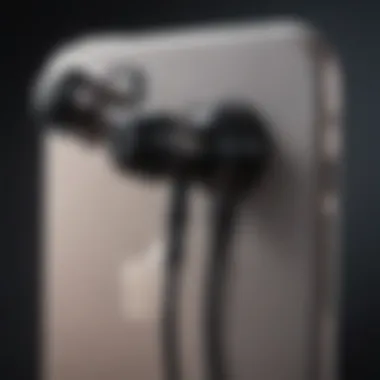Understanding the Implications of the iPhone 7's Earphone Jack Removal


Intro
The removal of the earphone jack in the iPhone 7 marked a significant shift in Apple's design philosophy. This decision did not come without its controversies and implications. Understanding this change requires an examination of what it meant for the ecosystem, users, and technology as a whole. This article delves deep into the factors leading to this decision, the experiences faced by users, and the alternate solutions that sprang up in its wake.
Product Overview
The iPhone 7, launched in September 2016, was a pivotal product for Apple. It was the first device to abandon the standard 3.5 mm earphone jack, a feature that had been ubiquitous in mobile phones for years. By removing this component, Apple sought to create a more streamlined device, enhancing both waterproofing and internal space.
Key Features and Specifications
The iPhone 7 came equipped with several defining features:
- Display: 4.7-inch Retina HD display with 1334 x 750 resolution.
- Processor: A10 Fusion chip for faster performance.
- Camera: 12MP rear camera with optical image stabilization.
- Storage Options: Variants with 32GB, 128GB, and 256GB storage.
- Battery Life: Up to 14 hours of talk time.
Comparison with Previous Models
Compared to the iPhone 6S, the iPhone 7 offered noticeable upgrades such as improved performance and better water resistance (IP67). However, the most talked-about change was undoubtedly the absence of the headphone jack. This decision positioned the iPhone 7 as a forward-thinking model, although it also alienated some users accustomed to traditional audio connections.
Performance and User Experience
The performance of the iPhone 7 was generally well-received. The A10 Fusion chip provided a substantial increase in speed and multitasking abilities. Users noted smoother performance while running multiple applications, making it particularly appealing for power users.
User Interface and Ease of Use
iOS on the iPhone 7 continued Apple's trend of intuitive design. The interface was user-friendly, allowing new users to adapt quickly. Yet, the absence of a dedicated earphone port led to a learning curve for some. The reliance on Bluetooth audio, while beneficial in some aspects, posed challenges such as latency and connectivity issues.
User Experience Feedback
Despite the sophisticated performance, user feedback varied. Some appreciated the focus on wireless technology while others lamented the increased reliance on adapters for traditional headphones. Many users expressed frustration over the necessity to always carry an extra dongle, impacting everyday usability.
Design and Build Quality
Design Elements and Aesthetics
The iPhone 7 maintained Apple's commitment to sleek design. The device was available in several colors, including a new jet black finish.
Materials Used in Construction
Construction predominantly involved aluminum, ensuring durability while providing an elegant look. Choosing these materials contributed to its premium feel.
Durability and Build Quality Assessments
The water and dust resistance feature was a significant improvement over its predecessors. This enhancement saw positive assessments among users who valued resilience in daily life.
Software and Updates
Operating System Features and Updates
At its launch, the iPhone 7 ran on iOS 10, which brought several new features, including an improved control center and enhanced Siri functionalities. Users noted that updates improved the overall experience over time.
App Compatibility and Availability
The App Store continued to support various applications, with many developers quickly adapting to the loss of the headphone jack, offering Bluetooth and wireless alternatives.
User Customization Options
Users were able to customize their experience with various audio settings and options for sound output. However, the mandatory reliance on wireless solutions created gaps in customization for users who wished for more traditional audio methods.
Price and Value Proposition
Price Point and Variants Available


The iPhone 7 launched at a price point starting around $649, depending on storage options. This positioning aimed to emphasize its premium nature.
Value for Money Assessment
While the price reflected a high-quality smartphone, some questioned whether the removal of the jack justified the cost for users who preferred traditional options. Comparisons with competing models showed a mix of features that could meet diverse user preferences.
Comparison with Similar Products in the Market
Similar devices, such as Samsung's Galaxy S7, still featured a headphone jack. This offered consumers more choices based on their needs, leading to diverse opinions on value and utility.
"Apple's decision to eliminate the headphone jack signifies a larger trend toward wireless technology, for better or for worse."
Intro to the iPhone Design Changes
In any discourse about technological advancements, the design changes of key products often provoke considerable interest. The iPhone 7, released in September 2016, is no exception to this pattern, particularly due to its notable adjustments in hardware and usability features. The removal of the earphone jack stands as one of the most significant shifts not only for Apple but for the smartphone industry as a whole.
This decision illustrates Apple's inclination toward a streamlined design. The omission of a 3.5mm jack allows for a slimmer profile, promoting aesthetic appeal and potentially offering more internal space for other components. Furthermore, it underscores a broader trend in consumer electronics: the move towards wireless technology and alternate audio solutions.
Understanding the implications of these design changes requires a closer examination of the reasons behind them. The impact on consumers’ audio experiences and expectations also requires attention, especially since it may dictate future product strategies in tech.
The Decision to Remove the Earphone Jack
Apple's choice to eliminate the earphone jack from the iPhone 7 was met with both innovation and skepticism. It reflects a pivotal moment in their design philosophy, encouraging users to adopt new technologies. Key motivations behind this shift included:
- Space Optimization: Removing the earphone jack frees up room for other components.
- Water Resistance: Omitting this port helps enhance the phone's waterproof capabilities, a growing consumer demand.
- Fostering Wireless Adoption: This decision supports the company’s push toward Bluetooth audio solutions, aligning with industry trends toward wireless devices.
Notably, the integration of the Lightning port not only replaces the traditional audio jack but also offers additional functionality, including digital audio processing. However, the abruptness of this change posed several challenges for users transitioning from older devices.
Initial Consumer Reactions
Immediate responses to this major design change varied widely across user demographics. Many early adopters expressed frustration, indicating strong emotional reactions driven by a perceived loss of convenience. Some common sentiments included:
- Resistance to Change: Users who preferred the standard 3.5mm audio jack felt sidelined in a rapidly evolving tech landscape.
- Concerns on Compatibility: Many worried about the unavailability of traditional headphones, as well as compatibility with various existing audio accessories.
- Adoption of Alternatives: On the other hand, some tech enthusiasts viewed this shift as an opportunity. They embraced Bluetooth devices and the potential of the Lightning audio ecosystem.
Despite initial backlash, consumer feedback gradually evolved as users learned to adapt. The discourse surrounding this decision reveals how design choices can have profound influences on user experience and satisfaction. Understanding these reactions provides a broader perspective on how technological shifts are perceived and adopted in real-world scenarios.
Technical Features of the iPhone
The removal of the earphone jack in the iPhone 7 marked a significant shift in audio technology. This innovation was not just about eliminating a physical port; it represented a fresh approach to how users engage with sound. Understanding the technical features of the iPhone 7 helps to appreciate the motivations behind Apple's design decisions and the advantages they bring.
Enhanced Audio Technology
The iPhone 7 incorporates advanced audio technologies that seek to enhance the overall listening experience. One of these technologies is the advanced digital signal processing that allows for improved sound quality. Apple invested in the development of stereo speakers, offering a richer audio output with fuller bass and clearer treble.
Another important feature is the incorporation of the Lightning connector, which is known for providing better audio quality than the traditional 3.5 mm jack. The digital nature of the connection allows for a clearer sound transmission with lower distortion levels. This means that, while some users lament the loss of the jack, they benefit from superior audio performance.
Additionally, the iPhone 7 features adaptive EQ, which tailors audio output based on the shape of the user’s ears. This innovation ensures that the audio experience is personalized, catering to individual preferences and enhancing user satisfaction.
Impact on Device Thickness and Design
The decision to remove the earphone jack also had implications for the design and thickness of the iPhone 7. By eliminating the jack, Apple was able to create a slimmer device. The iPhone 7 has a sleek design that is both visually appealing and ergonomic. This reduction in thickness not only enhances portability but also integrates better with modern aesthetics.
The absence of the earphone jack led to a rethinking of internal space. This available space is used to incorporate additional features, such as a larger battery to improve battery life. Furthermore, the design transition facilitated the strengthening of resistance to water and dust, enhancing durability—a crucial aspect for many users.
The Evolution of Audio Listening
The removal of the earphone jack in the iPhone 7 marked a pivotal change in how users interact with audio technology. This evolution of audio listening encapsulates broader trends in consumer technology and responds to the demands for better sound quality, convenience, and design aesthetics. As mobile devices have become essential tools for personal and professional communication, the manner in which audio is consumed has had to adapt. This section will explore significant elements, benefits, and considerations of this evolution.
Rise of Wireless Headphones
With the launch of the iPhone 7, many users began to embrace wireless headphones. The absence of a traditional earphone jack evolved consumer preferences toward Bluetooth technology. This shift has several advantages:


- Convenience: Wireless headphones offer ease of movement. Without cords, users can engage in various activities while enjoying audio.
- Sound Quality: Improved wireless technology has led to better sound quality. Many modern Bluetooth headphones provide high-fidelity audio that rivals wired options.
- Integration: Wireless headphones like Apple's AirPods integrate seamlessly with iPhone, enhancing user experience.
However, some users have raised concerns. Battery life is a critical issue, as the need to recharge becomes an inconvenience. Moreover, the learning curve involved in switching devices may deter some users from making the transition.
The Growth of Lightning Connector Accessories
Following the iPhone 7's release, the market saw significant growth in Lightning connector accessories. These accessories include not just earphones but also adapters, docks, and other audio devices designed specifically for the Lightning port. The benefits of this transition include:
- Compatibility: Devices designed for Lightning connections typically work with various iPhone models. This compatibility reduces the need for multiple headphone types.
- Quality Sound: The digital output through the Lightning connector can deliver higher quality audio than traditional analog connections.
- Additional Features: Lightning accessories can offer built-in controls and enhanced features, such as active noise cancellation.
Despite these advantages, users must consider their options carefully. Not all Lightning accessories provide the same level of quality, and some may find the transition challenging as they adapt to the new technology. The evolution of audio listening continues to shape user preferences and market offerings.
"The shift to wireless and Lightning accessories demonstrates not only a technological advancement but also a change in consumer expectations."
Alternatives to the Earphone Jack
The removal of the earphone jack from the iPhone 7 marked a significant shift in the way users interact with audio devices. Understanding alternatives to this fundamental feature is important for those adapting to this change. The subject encapsulates various methods users can employ for audio connectivity while balancing convenience and audio quality.
Using Lightning to 3. mm Adapters
One of the most immediate solutions after the removal of the earphone jack was the introduction of Lightning to 3.5 mm adapters. These adapters allow users to connect traditional headphones directly to their iPhone’s Lightning port. This method ensures compatibility with a broad range of headphones that consumers already own, thus minimizing disruption.
- Convenience: The adapter is small, portable, and easy to use. It allows for seamless transitions between wired and wireless audio devices.
- Backup Option: For users who prefer to retain their existing headphones, the adapter serves as a reliable alternative.
- Audio Quality: Utilizing the Lightning port can potentially enhance audio quality, as digital signals are processed differently than analog signals.
However, it is important to consider that the adapters may be prone to wear and tear, leading to potential connectivity issues over time.
Exploring Bluetooth Options
Bluetooth technology emerged as a pivotal alternative post the earphone jack elimination. Wireless headphones and earbuds not only provide convenience but also contribute to a cleaner design aesthetic for the iPhone 7.
- Wireless Freedom: Users can enjoy music without being tethered by wires, allowing for greater mobility and comfort.
- Improved Technology: Modern Bluetooth devices often come equipped with enhanced audio technologies, such as aptX or AAC, that can offer sound quality comparable to wired headphones.
- Integration with Apple Ecosystem: Devices like the AirPods integrate seamlessly within the Apple ecosystem, allowing for effortless connection and automatic switching between devices.
The downside to Bluetooth is battery dependency. Users must ensure that their devices are regularly charged to avoid interruptions in their listening experience.
The Role of Third-Party Accessories
Third-party accessories have emerged as crucial alternatives for users seeking to replace the earphone jack. Various brands manufacture adapters, Bluetooth headphones, and other devices to enhance audio experience.
- Wide Variety: There are numerous options available, catering to different preferences and budgets. From affordable adapters to premium audio devices, users are no longer limited to Apple’s offerings.
- Functionality: Many third-party accessories include additional features, such as in-line controls or added functionality for calls and voice assistants.
- Custom Experience: Users can choose devices tailored to their specific needs, whether they seek noise cancellation, workout-ready headphones, or high-fidelity audio.
While third-party products can offer great benefits, users should be cautious about quality and warranty claims. Choosing reputable brands will ensure a good balance between performance and reliability.
As the industry adapts to the absence of the earphone jack, understanding these alternatives helps users navigate their audio experience effectively.
The alternatives presented reflect a significant shift in audio consumption, merging functionality with evolving user expectations. As technology progresses, users will continue to find new ways to enhance their audio experience.
User Adaptation and Feedback
The removal of the earphone jack in the iPhone 7 was not merely a design choice but sparked significant change in how users interacted with their devices. This shift demanded adaptation from users, in both habits and the physical accessories they chose to use. Understanding user adaptation and their feedback sheds light on the evolving landscape of audio technology. By analyzing how consumers navigated these changes, we gain insights into their preferences and the overall trajectory of Apple’s audio innovations.
Adaptation Strategies for Users
With the absence of the classic 3.5 mm earphone jack, iPhone 7 users had to seek effective methods to continue enjoying their audio experiences. Some strategies that emerged included:
- Embracing Wireless Technology: Many users gravitated towards Bluetooth headphones, making a complete transition away from wired connections. Brands like Apple, with their AirPods, made this shift more seamless.
- Utilizing Lightning-Compatible Accessories: Buyers opted for headphones that could connect directly through the Lightning port, maintaining a wired experience albeit through a different connector.
- Adopting Adapters: Some users chose to purchase Lightning to 3.5 mm adapters, allowing them to use their existing headphones without switching entirely to new technology. This offered a temporary solution as they adjusted to new formats.
These strategies allowed users to retain functionality while navigating a new audio framework. The transition was not without challenges, as many users faced issues with battery life and connectivity. Nonetheless, with time, most adjusted to the new norms.
Analyzing User Feedback Over Time
User feedback regarding the loss of the earphone jack reflects a diverse range of opinions and experiences over time. Initially, the response was largely negative, with many expressing frustration at being forced to adapt to new accessories. Over the years, however, several trends in user feedback became apparent:


- Initial Resistance Followed by Acceptance: Initially, many users criticized Apple’s decision, indicating a strong preference for traditional wired headphones. Over time, a growing segment of users reported satisfaction with wireless alternatives as technology improved.
- Desire for Convenience: Feedback indicated that wireless headphones offered more convenience. Users enjoyed the freedom from wires, particularly during activities like exercising or commuting.
- Adjustments to Accessory Ecosystem: As new accessories were developed, users shared their experiences on platforms like Reddit. Discussions often centered around the effectiveness and quality of various adapters and wireless options, influencing purchasing decisions in the market.
"The quality of sound from my new wireless headphones surprised me. I didn't think I would like them, but now I can't imagine going back to wired options."
Comparative Analysis with Other Apple Products
The significance of analyzing the earphone jack status across other Apple products stems from the need to understand the broader implications of Apple's design philosophy regarding audio input. As technology evolves, Apple's strategies change to stay relevant within the competitive tech landscape. This section will delve deep into how subsequent models, starting from the iPhone 7, either embraced or rejected the concepts introduced by removing the earphone jack.
Earphone Jack Status in Subsequent Models
The straight removal of the earphone jack from the iPhone 7 set a precedent. Apple continued this trend with later models, including the iPhone 8, iPhone X, and beyond. The absence of the 3.5mm port became a hallmark of the iPhone's design philosophy aimed at increased water resistance and a sleeker profile. This removal often leads to reduced internal components, allowing for more space for advanced circuitry or battery improvements. Users had to adapt, relying more on wireless headphones or accessories like the Lightning to 3.5mm adapter.
Each model thereafter placed greater emphasis on wireless technology. The AirPods, which gained popularity rapidly, demonstrate Apple's push toward a fully wireless audio experience. Making wireless headphones a principal part of the audio ecosystem became evident, influencing user behavior and product offerings.
"The transition toward a fully wireless experience is not merely a trend; it marks a definitive shift in how users interact with audio devices."
How Other Apple Devices Address Audio Input
Apple's other devices also reflect this transition. For instance, the iPad Pro models follow a similar design cue, which includes removing the headphone jack. This continues the narrative Apple set forth with the iPhone 7, reinforcing their commitment to wireless solutions. Apple simultaneously promotes its Lightning connector and Bluetooth technology across devices like the MacBook and Apple Watch.
The integration of the Lightning port into various devices creates a more cohesive ecosystem for users. Accessories now often cater towards wireless connections or the Lightning format. This creates both convenience and sometimes frustration, as the dependency on compatibility adds a layer of complexity in a segmented product line.
Epilogue
This comparative analysis illustrates not only the choices presented around the earphone jack in the iPhone 7 but also encapsulates a transition which is evident across Apple’s product range. The implications of these decisions shape the audio landscape for consumers while presenting new opportunities and challenges in adapting to technological innovations.
Market Reactions and Competitor Strategies
The removal of the earphone jack in the iPhone 7 sparked significant conversations across the tech industry. This move not only represented a shift in design philosophy but also influenced the broader market strategies of competitors. The adjustment to wireless technology becoming central to audio solutions cannot be overlooked. It made the landscape ripe for new innovations in audio technology while compelling other brands to rethink their approaches. The importance of market reactions and competitor strategies derives from how these events shape consumer preferences and drive product evolution.
Industry Response to Apple's Innovation
Apple's innovation did not go unnoticed. Industry experts and competitors studied the implications of removing the earphone jack closely. Companies like Samsung and Google had to assess their own strategies in light of Apple's approach. The immediacy of responses was telling of the competitive nature of the market. Some brands began launching their own versions of wireless earbuds or enhancing the quality of their wired headphone offerings. They aimed to entice users who were initially hesitant about making the switch to a fully wireless environment.
- Some responses included:
- Enhanced Bluetooth technologies in new devices.
- Rapid development of wireless headphone models.
- Promotion of adaptability in audio hardware, such as Lightning adapters.
"Apple has always had a knack for setting trends; other companies can't ignore their moves."
Above all, the industry witnessed a push toward more seamless wireless integrations. Companies that traditionally relied on wired audio began to invest in research and development, aiming to catch up to the new standard set by Apple. The removal of the earphone jack thus catalyzed a broader conversation on the future of audio technology.
Impact on Competitors' Product Designs
The impact on competitors' product designs was substantial. Many brands opted to follow Apple’s lead, introducing their own models without traditional headphone jacks. This strategic pivot required reframing their product lineups to accommodate new forms of wireless audio devices. The trend resulted in significant design ramifications that went beyond just the headphones.
- Key considerations included:
- Redesigning smartphones to eliminate unnecessary ports.
- Developing bespoke wireless audio devices that cater specifically to consumer demands.
- Assessing how to balance features and pricing against that of Apple products.
Some manufacturers began to include proprietary connectors, reflecting a need to differentiate themselves in a competitive market. The competitive response thus illustrated how critical Apple's innovation was in prompting a reevaluation of audio solutions. Overall, the removal of the earphone jack served as a turning point, propelling both design evolution and new consumer expectations for audio technology.
Finale: Reflections on Apple's Audio Journey
The removal of the earphone jack in the iPhone 7 marks a significant point in Apple's audio evolution. This decision was not only about creating a sleeker design but also about setting a new standard for audio technology. The transition from traditional headphone jacks to digital alternatives reflects a broader shift in user preferences.
Summarizing the Shift in User Preferences
Over recent years, user preferences have shifted towards wireless and digital audio solutions. Many consumers appreciate the convenience and portability offered by wireless headphones. The popularity of brands like Apple AirPods has showcased this trend. Users now favor products that integrate seamlessly with their devices, emphasizing functionality over the traditional experience of using wired headphones.
This shift has also brought about changes in how music is consumed. Streaming services continue to change the landscape of audio consumption. In contrast to previous methods, users look for quality sound combined with accessibility. Many are now willing to invest in quality digital accessories that provide enhanced audio experiences.
As this trend continues, we see that the removal of the jack has not deterred consumers. Instead, it has driven innovation in audio technology and adaptation towards new formats.
Looking Ahead: Future of Audio in Apple Devices
Looking into the future, Apple's stance on audio connectivity appears poised to continue evolving. It is likely that the company will further enhance wireless audio technologies. Improved Bluetooth capabilities may become a focal point in upcoming devices, allowing for higher quality sound transmission and lower latency.
Furthermore, advancements in smart home integration could customize and enhance user experiences. With voice-activated technologies becoming more pervasive, seamless audio integration could be extended to various environments. Such transformations may redefine how users interact with audio in daily life.



